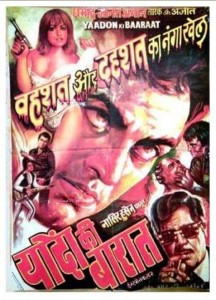Bad Advice Wednesday: Take Your Work to the Movies
categories: Bad Advice / Cocktail Hour / Movies
Comments Off on Bad Advice Wednesday: Take Your Work to the Movies
 Sometimes when I’m done with a scene or a section in a story or chapter or essay, I like to test it by thinking about how it would look as a movie. One way to help envision this is to write the script. No, really. Turn a section of your story or chapter or essay into a movie script. Nothing fancy: just take the scene or section (something short—you don’t need to kill yourself) and imagine what the first image in its movie would be, what the first words would be and who would say them, where the action would be, how the drama would fall. If you’ve been working too much in the mode of the writer sitting at her desk and talking, you’ll find that all you’ve really got is voiceover. If you’ve been sitting and thinking, ruminating in writing, you won’t even have that.
Sometimes when I’m done with a scene or a section in a story or chapter or essay, I like to test it by thinking about how it would look as a movie. One way to help envision this is to write the script. No, really. Turn a section of your story or chapter or essay into a movie script. Nothing fancy: just take the scene or section (something short—you don’t need to kill yourself) and imagine what the first image in its movie would be, what the first words would be and who would say them, where the action would be, how the drama would fall. If you’ve been working too much in the mode of the writer sitting at her desk and talking, you’ll find that all you’ve really got is voiceover. If you’ve been sitting and thinking, ruminating in writing, you won’t even have that.
Often, new writers start with the general, with lots of background information, which is hard to film:
The camera sweeps in over a little New England village. A tussle in the foreground slowly resolves as the camera approaches into kids. Kids playing in the snow.
VO: When I was growing up there was more snow than there is today. Or, at least, that’s how it seems now. We kids would make forts that might take days to complete, and mount battles that might take weeks. I was born in Roberts, Vermont, in 1987, and I’ve never left, though my friends and family encouraged me to do so, especially after the awful thing that happened to my brother.
If your script is all VO (voiceover, sorry), that is, if it’s all you at your desk talking to your reader as above, the movie you’re hoping to instill in the reader’s head is never going to come to life. You want that VO guy to quit yammering on and say, “One day…” So:
Snowy New England village, day. A crowd of kids throwing snowballs at an old house. The door opens, and an old man with a shotgun tumbles out.
Old man: What do you little rats think you’re doing?
Kid one: Stuff it, you old fart!
Kid two (throwing an ice ball): Bite me, old man Miller!
Suddenly, the shotgun goes off. The report is very loud and echoes. The gang of kids runs off, laughing derisively. Slowly, we realize that one kid has not run away but is lying in the snow, face down.
Etc.
What happens for me in this process is that I start to hear the individual voices of my characters, and more important, get to hear if what they’re saying could ever be brought to life by an actor. Long passages of dialogue in prose might not translate, once you start to think of the words as something actually said. I watch the film in my head, and then I go back and revise.
Casting your scene can help, too. In nonfiction, your actors are already chosen—they are your people. What would you hope to have gotten of them with a camera? Is something comparable to the best a camera might capture happening in your prose? The way your boss keeps looking off over your head? In fiction, you can plug whatever actor you want, and begin to catch in your imagination tics and gestures and physical detail that you might otherwise miss.
Scripts are schematic—the camera and the actors and the director and the editor do much of the work that we prose writers have to do ourselves. But if at times we can imitate the camera, and if always we can imagine the actors, put them into a fully realized set, we can put worlds into motion, remembering that the reader’s mind is a screen to project upon.

